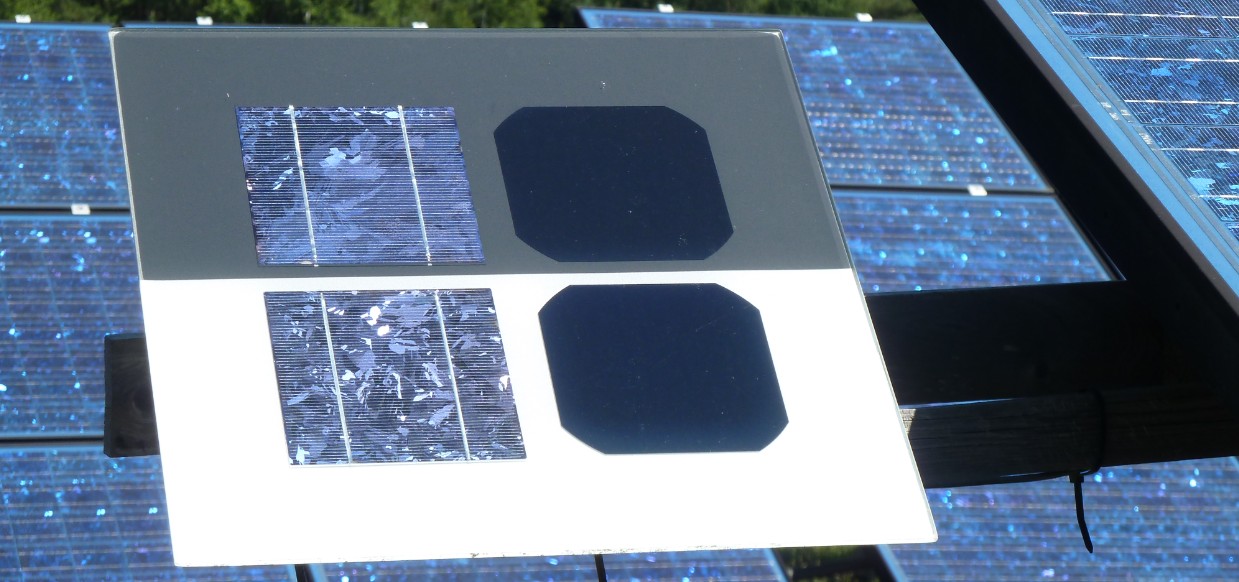
The influence of aluminum paste on the performance of polycrystalline silicon solar cells
In order to explore the influence of aluminum powder and glass powder in aluminum paste on the performance of crystalline silicon solar cells, three types of aluminum pastes were prepared by using aluminum powders with different particle sizes and grades and glass powders of different components, and these three types of aluminum pastes were subjected to the same process 3 sets of polycrystalline silicon solar cells were prepared. Through comparative analysis, it is found that when the proportion of small-size aluminum powder (less than 5 μm) is greater than 50%, the conductivity of the aluminum layer is significantly improved, but aluminum beads are prone to precipitate on the surface, which increases the unevenness of the silicon wafer; the lead-containing glass powder can Effectively improve the photoelectric conversion efficiency of the battery, while reducing the thickness of the regeneration layer, so that the warpage of the battery is reduced. Under the optimal process combination conditions, the photoelectric conversion efficiency of the solar cell reaches 17.63%.
1 experiment
Mix terpineol, ethyl cellulose, butyl carbitol, lecithin, and other organic additives in proportions, and stir at 100°C for 2 h at a constant temperature as an organic carrier. Mix the organic carrier, glass powder and aluminum powder in a weight ratio of 21:3:76, and continue to stir for 2 to 3 hours. Grind the stirred slurry through a three-roll mill for 5 to 7 times to form a uniformly dispersed aluminum slurry. Using aluminum powders A1 and A2 with different particle size gradations and glass powders B1 and B2 with different compositions, three aluminum paste samples were prepared according to the aforementioned steps. Using the newly developed aluminum paste formula and the same sintering process system, a 156 mm×156 mm P-type substrate polycrystalline silicon cell was prepared. The battery pack numbers are C1 (corresponding to aluminum paste containing aluminum powder A1, glass powder B1), C2 (aluminum paste containing aluminum powder A2, glass powder B1), and C3 (aluminum paste containing aluminum powder A1, glass powder B2).
The aluminum pastes containing aluminum powders A1 and A2 were sampled and dried at 300°C for 2 h. The morphology of the dried aluminum powders was observed with a scanning electron microscope (SEM). A four-probe tester was used to test the resistivity of the aluminum layer. The composition of glass powder was analyzed by inductively coupled plasma atomic emission spectrometer (ICP-AES). Scanning electron microscope (SEM) was used to observe the morphology of the cell section. Use a solar automatic test sorting machine to test the photovoltaic performance of the battery (AM1.5, 100 mW/cm2, 25 ℃). A feeler gauge is used to measure the battery warpage.
2 Results and discussion
2.1 The influence of aluminum powder particle size
It can be seen from Table 1 that the two types of aluminum powders are all compounded by aluminum powder particles of different particle sizes. The mass of aluminum powder particles with a diameter of less than 5 μm in aluminum powder A1 accounts for about 80%, and that in aluminum powder A2 Coarse aluminum powder with a particle diameter of 5 μm or more has a larger specific gravity. In the two kinds of aluminum powders, aluminum powders with different particle size ranges all occupy a certain proportion. Large aluminum powder particles are easy to form a continuous conductive path, but there are larger gaps. Aluminum powder particles with a small particle size can play a filling effect and make the conductive aluminum layer more dense. In order to further understand the filling effect of the two aluminum powders made into aluminum paste, the two aluminum pastes containing aluminum powder A1 and A2 were sampled and dried, and the morphology of the dried aluminum paste was observed by SEM. The results are shown in Figure 1. Shown. The results shown in Figure 1 correspond to the particle size distribution of aluminum powder in Table 1. It can be seen that both types of aluminum powder have good filling effects. As the content of small particles in A1 aluminum powder is higher, the filling effect is more compact.
Observe the appearance of the back surface of the two groups of cells C1 and C2, and use the four-probe method to test the conductivity of the back aluminum layer. The results are shown in Table 2. Comparing the appearance of the back side of the two sets of batteries, it can be seen that although the median particle size of the two aluminum powders are different, they all have a smooth and flat appearance, indicating that the appearance of the aluminum layer is mainly affected by the particle size ratio of the aluminum powder. If the size of the aluminum powder particles is properly matched, a flat aluminum layer can be formed after sintering. The appearance of aluminum beads is not only related to the particle size of the aluminum powder, but also affected by various factors such as the sintering process and the composition of the glass powder. Compared with the results in Table 2, it can be seen that when the small and medium-sized particles in the aluminum powder account for a relatively large amount, the Increased chance of appearance. This phenomenon is consistent with the research results of Zhang Haizhu et al. [6]. In the process of high-temperature sintering, the pores between aluminum powder particles will shrink. The compressive stress generated during the shrinkage process is inversely proportional to the particle size of the aluminum powder. The specific surface area of the small-diameter aluminum powder particles is larger, and the sintering compressive stress is also higher. Too much aluminum powder with small particle size will cause severe shrinkage, thereby squeezing the aluminum powder in the molten state to form aluminum beads. Comparing the average resistivity of the aluminum layer on the back of the two sets of batteries, it can be seen that due to the better filling effect of A1 aluminum powder, the conductivity of the film layer is also improved.
2.2 The influence of glass powder composition
Table 3 shows the composition of glass powder. It can be seen from Table 3 that glass frit B1 mainly contains lead elements, and glass frit B2 is bismuth-based lead-free glass. Table 4 shows the average performance of the batteries using glass frit B1 and B2, respectively.
Comparing the results in Tables 3 and 4, it can be found that the lead-containing glass powder B1 can improve the electrical performance of the battery. The lead element in the glass powder has a strong erosion effect on the oxide layer on the surface of the aluminum powder, so the lead-containing glass powder B1 can better promote the bonding of the aluminum powder to form an excellent conductive channel, and at the same time facilitate the mutual diffusion of aluminum and silicon elements , So as to improve the performance of aluminum doped back electric field [12-14]. Comparing the performance of battery packs C1 and C2, it can be seen that when the aluminum paste contains aluminum powder A1 and glass powder B1, the battery performance is the best.
With the upgrading of the manufacturing process, the thickness of the crystalline silicon solar cell is continuously reduced, causing the warpage and deformation of the cell to become more and more serious. Comparing the warpage of the two battery sets in Table 4, it can be seen that the glass frit B1 is beneficial to reduce the warpage of the battery. In order to explore the reason, one battery was selected from each of the two sets of batteries, and the cross-sectional morphology of the battery was observed by SEM. The result is shown in Figure 2. During the high-temperature sintering process, a new thin layer or regeneration layer is formed between the silicon substrate and the aluminum layer. The regeneration layer is further divided into an aluminum-silicon alloy layer (silicon mass fraction is about 12%) and an aluminum-doped back electric field layer. Studies have shown that the warpage of the battery will increase as the thickness of the regeneration layer increases [15]. It can be seen from Figure 2 that the battery using glass powder B1 has a thinner aluminum-silicon alloy layer with a thickness of about 2 μm, and the battery using glass powder B2 has a thickness of about 6 μm. Combining the results in Table 4, it can be seen that the back electric field thickness of the two sets of batteries is about 6 μm. Therefore, the thinner alloy layer means that the thickness of the regeneration layer is also smaller, so that the warpage problem of the battery will be improved.
3 Conclusion
1) The flatness of the aluminum layer after sintering is mainly affected by the particle size gradation of the aluminum powder. When the content of aluminum powder less than 5 μm is large, aluminum beads are likely to appear. The average resistivity of the aluminum layer of the C1 battery cell is reduced by about 11% compared to the C2 battery, indicating that the particle size gradation of aluminum powder A1 can effectively improve the conductivity of the aluminum layer.
2) When the aluminum paste composition is glass powder B1, the thickness of the regeneration layer between aluminum and silicon is very small, and the average warpage of the battery is 1.0~1.1 μm. The glass powder B1 can reduce the thickness of the aluminum-silicon alloy layer of the battery to about 2 μm, which is beneficial to reduce the warpage of the battery.
3) Using glass powder B1, under the same process conditions, the thickness of the back electric field can be increased, and the photoelectric conversion efficiency of photovoltaic cells can be improved. When the aluminum paste contains glass powder B1 (mass fraction of 3%) and aluminum powder A1 (mass fraction of 76%), the battery performance is the best, and the average aluminum layer resistivity is only 27.4 μΩ·cm, and the average photoelectric conversion in the group The efficiency is 17.63%.

